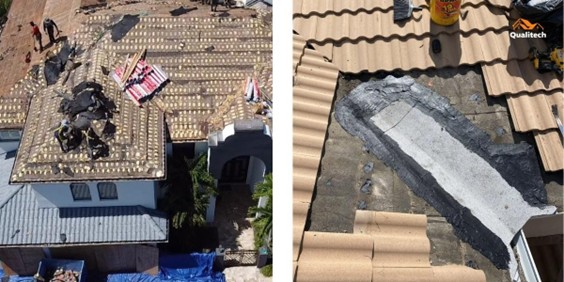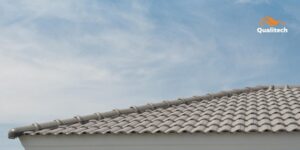
Your roof is your home’s first line of defense against rain, wind, sun, and even tropical storms. Keeping it in good condition not only protects the structure but also improves energy efficiency and preserves property value. Ignoring minor problems often leads to leaks, mold growth, structural deterioration, and eventually the need for a full roof repair, re-roofing, or even complete roof replacement.
Why Roof Maintenance and Repair Matter
- Protects your home from water damage and leaks.
- Prevents mold, mildew, and structural rot.
- Improves energy efficiency, reducing heating and cooling costs.
- Preserves curb appeal and increases property value.
A well-maintained roof ensures safety, comfort, and long-term savings.
Common Causes of Roof Damage
- Weather: Heavy rain, hail, and strong winds (especially hurricanes) can crack tiles, lift shingles, or loosen metal panels.
- Age: Every roofing material has a limited lifespan and naturally deteriorates over time.
- Poor Installation: Improper fastening or sealing shortens the roof’s life and increases the risk of early failure.
- Trees and Debris: Falling branches or clogged gutters trap moisture and damage roof surfaces.
- Inadequate Ventilation: Overheated attics dry out shingles, while trapped moisture encourages mold and rot.
Warning Signs That Your Roof Needs Attention
- Interior water stains or active leaks.
- Missing, cracked, curling, or loose shingles.
- Displaced or broken roof tiles.
- Sagging rooflines or soft decking.
- Excess granules from shingles inside gutters.
- Mold, algae, or moss growth on roof or attic.
If you notice any of these, schedule a roof repair inspection immediately.
Roofing Materials and Their Lifespan
Different roofing materials require different repair methods and have varying lifespans:
| Material | Lifespan | Repair Frequency |
| Shingle roof | 15-20 years | Moderate |
| Tile roof | 30 -35 years | Moderate |
| Metal roof | 35-40 years | Low |
Roof Repair vs. Roof Replacement – How to Decide
When a Roof Repair Is Enough
- Damage is minor and limited to small sections.
- The roof is relatively new (under 12–15 years for shingles, under 25 for tile/metal).
- The structure and decking are still solid.
- Example: shingles roof repair after a storm or re-securing a loose metal panel.
When Re-Roofing or Roof Replacement Is the Best Choice
- The roof is nearing the end of its expected lifespan.
- Widespread leaks or recurring water intrusion.
- Repairs would only be temporary and not cost-effective long term.
- Visible structural damage such as sagging or rotten decking.
- Example: a 20-year-old shingle roof with leaks in multiple areas, or a tile roof where the underlayment has failed.
Benefits of Hiring a Professional Roofing Contractor
- Safety: Roofing work is dangerous, especially on steep slopes.
- Quality & Warranty: Professionals provide workmanship warranties and ensure proper installation.
- Cost Savings: Proper roof repair or installation extends lifespan and prevents bigger expenses later.
- Inspection Expertise: Contractors can identify hidden issues that homeowners often miss.
Maintenance Tips to Extend Roof Life
- Inspect your roof at least twice a year (spring and fall).
- Clean gutters and downspouts regularly.
- Trim tree branches near the roofline.
- Check attic for leaks, mold, or poor ventilation.
- Remove algae or moss growth early.
- Schedule a professional inspection every 2–3 years.
Roofing Repair and Replacement FAQ
Check out the most frequently asked questions about roof repair and roof replacement.
Q1: Can I repair my roof myself?
DIY roof repair may seem like a money-saving option for small issues, such as replacing a missing shingle. However, it comes with significant risks: falls, improper sealing, and undetected hidden damage. Incorrect repairs often lead to bigger problems and more costly roof replacement down the line. For safety and long-term durability, it’s always best to hire a professional roofing contractor.
Q2: How long does a roofing repair take?
The time frame depends on the type of repair:
- Shingles roof repair: a few hours for small sections.
- Tile roof repair: one to two days, depending on tile availability and underlayment condition.
- Re-roofing or roof replacement: typically 2–5 days, depending on size and materials.
Q3: How often should I inspect my roof?
At minimum, schedule inspections twice a year—once in spring and once in fall. Additionally, always check your roof after major storms. Regular inspections help detect early signs of damage and determine whether a roof repair is enough or if a full roof replacement may be needed.
Q4: Does insurance cover roofing repair or replacement?
Most homeowner insurance policies cover roof repair or roof replacement when the damage is caused by sudden events such as storms, hail, or fallen trees. However, normal wear and tear due to age or lack of maintenance is usually not covered. Always review your policy details and request a professional inspection for proper documentation.
Final Thoughts
Roofing repair is essential for maintaining the safety, efficiency, and value of your home. Whether you need minor shingle replacement or major structural work, addressing problems early prevents bigger issues.
At Qualitech Home Services, we specialize in top-quality roofing repair, using the best equipment, experienced staff, and reliable service to protect your home. Contact us today by clicking here for a free inspection and consultation!


